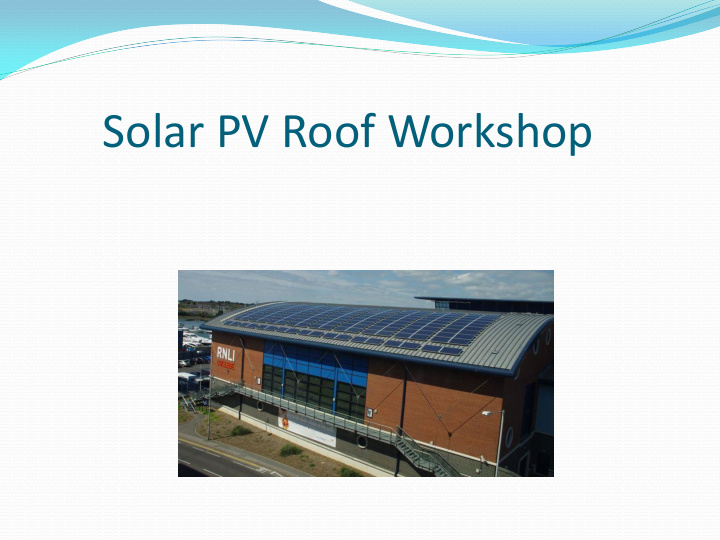



Solar PV Roof Workshop
Factors to take into consideration Following are all relevant to suitability and often the cost of a PV installation: • Orientation and slope • Shading • Planning • Roof surface ad supporting structure • Access • Power supply • Energy efficiency and FiT • Ownership and legal issues • Use of generated energy
Orientation and roof slope Ideally between SE and SW but not always Avoid N facing! See MCS guide or EST table Max production at about 35° roof slope Steeper slope performs better in winter and vice versa Different slopes or directions adds complexity and cost
Shading Distant shading versus nearer at hand Distant over whole array and quantified Closer at hand with effect on individual panel has disproportionate effect on output. Either move/cut down source or reposition array or use optimisers/micro-inverters at additional cost/complexity
Planning Permitted Development allows many installations without recourse to planners Affecting the setting of a Listed Building or Conservation Areas often the issue PD on commercial sets margin all round Always worth checking – especially for DNPA!
Roof Surface and supporting structure FiTs good for 20 years, PV panels for longer Taking array off can be expensive Choose roof that is probably going to last the course Slate surfaces will cost more than tiles, dodgy more than sound, suspect more than sound Installer must check/measure supporting structure – undertake specialist survey if in doubt – cost to who? Is there any warranty that might be invalidated?
Access Some form of scaffolding is almost inevitable Ladders only sounds like poor H & S elsewhere Portable sometimes if gentle slope, low height and flat working area Atriums, conservatories and other tricky access issues will add to scaffolding cost Does the work involve going on 3 rd party’s property?
Power supplies District Network Operator (WPD) sets export limits These depend on existing connection and local network Domestic scale connection limited to 16A = 3.68 kW 3 Phase supply = 11.4 kW but can ask if higher allowable. Upgrading usually involves substation or transformer work which will be charged for – typically £1000s. Larger Installations will require quote from WPD – depends on a number of factors. South Brent Community Energy Society 225kW turbine £18,000 when only about 150 m from connection point. Poor state of existing wiring will add cost
Energy efficiency and FiTs EPC level D requirement (55 points) since 2012 or lower FiT rate applies Community group exemption from 55 points requirement if the CG is a Coop, BenCom IPS or CIC but EPC still required. Can also get pre-accreditation to preserve FiT rate after next degression. FiTs next due to change ……?
Ownership and Legal Who will own the PV, do the maintenance, claim FiT etc? Usually need a lease for 20 years + Often 3 rd party interests such bank providing mortgage Unless “take it or leave it” approach taken, will need respective parties solicitors to agree a lease – at cost. “Bulk buy” via Housing Association a way of making cost effective for domestic. TRESOC examples. Or only much larger installations where £2 – 3000 is proportionally affordable?
Use of generated energy Ability of domestic property to use all generated energy is limited unless work from home or appliances on timer The more that can be used locally the more cost effective the overall installation – or sell to occupier as PEC Renewables Schools, surgeries, shops are good examples of high daytime users. Cold stores even better. In the end may have to settle for reduced carbon emissions rather than securing a higher income from the PV.
Photovoltaic Photovoltaics (PV) are a solar panel system used to generate electricity. When light hits the PV cell it creates an electric field across the two or more layers of silicon and generates an electric current. There are three types of PV cells with a variety of efficiencies. Monocrystalline are the most efficient next are Polycrystalline and lastly Amorphous. Usually there is a gap between the panel and the roof surface to allow air to circulate, unlike solar thermal panels PV loose efficiency the hotter it becomes. A 3 kw PV array which will provide on average 2,600 kWh a year requires 20 metres squared area with a cost of £4000. This house uses about the same quantity of electricity but note the mismatch of summer vs winter for generation vs consumption
Recommend
More recommend